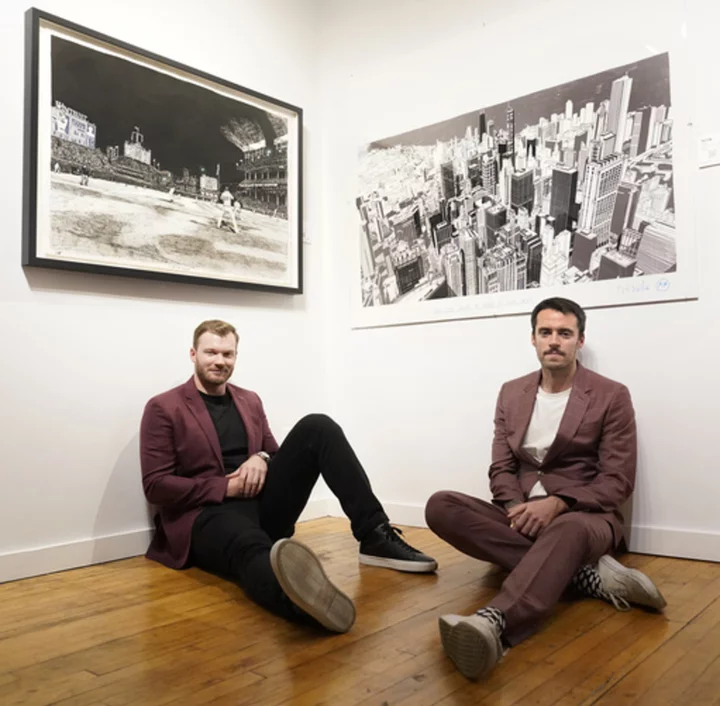CHICAGO (AP) — Not long after Ian Happ got called up to the majors in 2017 by the Chicago Cubs, a boyhood dream realized with a storied franchise coming off a historic championship run, he was looking for pictures to hang in his apartment.
From that simple desire came a vivid vision and one unlikely partnership with an English artist who made it come to life. Happ wanted to show Wrigley Field from a different viewpoint.
“I had this experience over and over with bringing people down on the field,” he said. “They’d been to 20, 50, 100 games at Wrigley, but never been on the field. And everybody would have the same experience of looking back up just in awe from seeing it from from down low. And I thought that was such a cool experience that if I could bring that to more Cubs fans, more people, it would make the project really special.”
Happ's view of Wrigley Field is on display at a Chicago art gallery — also where he got engaged last year — for a few more weeks as part of a series of drawings by Patrick Vale.
He commissioned the artist to create three large ink pictures of The Friendly Confines from a player's perspective five years ago. Instead of having pictures to hang in his apartment, the partnership led to something quite different.
It became Happ's “Through My Eyes" project, where fans can purchase prints and the proceeds go to his charity. The drawings are part of Vale's “See What I See” exhibit, a series of drawings of cityscapes so detailed they almost look like photographs. They're on display at Chicago's Gallery Victor through Aug. 26.
All this is rooted in Happ simply looking for artwork after he was called up by the Cubs. He had a great view and wanted pictures of the city.
A college teammate at the University of Cincinnati who'd become an architect in New York gave him the names of several artists. One was Vale.
The level of detail in Vale's cityscapes stood out to Happ, with every brick and window, it seemed, in each building being drawn. And through the course of their conversations, a different vision emerged.
Happ got the idea to bring Vale to Chicago and draw Wrigley Field from a viewpoint few fans get to experience, from a player's perspective looking out onto the field and into the stands of the famed ballpark.
The reaction friends and relatives had when he would bring them onto the field, even those who had been to a bunch of games on the North Side, also helped trigger the idea. So did Happ's appreciation of the ballpark and its history.
“My first year in '17, we had the old dugout,” he said. “We had the tiny old dugout with kind of a tunnel system, you know, just those old walkways and the things that you would find and the experience of feeling like (Ryne) Sandburg and Ernie Banks and (Ron) Santo and those guys sat in the same dugout. That was just such an amazing experience.”
Happ brought Vale to Chicago in September 2018 and showed him around Wrigley. It was an odd pairing, considering Vale, a rugby and cricket fan from Bristol in England's West Country, knew little about baseball. But he got the connection fans have with Wrigley.
“I understand when people talk about baseball and their connections to family and family stories and childhood,” said Vale, who lives in New York. “It's the same for me with cricket. I can remember summers in the garden with grandpa and listening to the radio.”
Happ had to explain the significance of the 400 feet sign in center field and the iconic manual scoreboard and ivy. He had to go over the proper positioning of the players and the umpires. Happ also explained what it feels like standing in the field under the bright lights or at the plate with the crowd roaring.
Vale was a quick study. He took pictures and used them to help him create images that are striking in their detail. He'd send rough drawings to Happ, who like a teacher or editor would mark them up in red ink.
“He got to know the characters that you see at Wrigley Field,” gallery owner Victor Armendariz said. “So the guy who's selling drinks or the kids who are waiting to get their ball signed.”
The pictures — in charcoal and most of them black and white — show everything from the faces of the fans, with some holding “W” signs, and the vendors to the stats and graphics on the videoboards. The flags above the manual scoreboard whip in the wind. They show a celebration unfolding near third base from the perspective of someone looking down the left-field line. And there's the view from the home dugout looking toward third base and right field as the pitcher delivers with the bright lights shining.
“He was talking about very specific moments,” Vale said. “The scoreboard needs to feel like the scoreboard, right? I had to respect it and the place.” ___
AP MLB: https://apnews.com/hub/mlb

